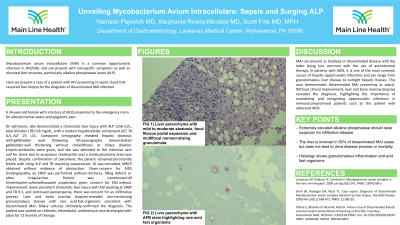Sunday Poster Session
Category: Liver
P1305 - Unveiling Mycobacterium Avium Intracellulare: Sepsis and Surging ALP
Sunday, October 27, 2024
3:30 PM - 7:00 PM ET
Location: Exhibit Hall E

Has Audio

Harrison Pajovich, MD
Lankenau Medical Center
Philadelphia, PA
Presenting Author(s)
Harrison Pajovich, MD1, Stephanie Rivera Morales, MD2, Scott Fink, MD2
1Lankenau Medical Center, Philadelphia, PA; 2Lankenau Medical Center, Wynnewood, PA
Introduction: Mycobacterium avium intracellulare (MAI) is a common opportunistic infection in HIV/AIDs and can present with nonspecific symptoms as well as elevated liver enzymes, particularly alkaline phosphatase levels (ALP). Here we present a case of a patient with HIV presenting in septic shock that required liver biopsy for the diagnosis of disseminated MAI infection.
Case Description/Methods: A 34-year-old female with a history of AIDS presented to the emergency room for altered mental status and epigastric pain. On admission, labs demonstrated a cholestatic liver injury with ALP 1256 IU/L, total bilirubin (TB) 0.8 mg/dL, with a modest hepatocellular component AST 78 U/L, ALT 25 U/L. Computed tomography revealed hepatic steatosis with gallbladder wall thickening. Ultrasonography demonstrated gallbladder wall thickening without cholelithiasis or biliary dilation. Empiric antibiotics were given, and she was admitted to the intensive care unit for shock due to acalculous cholecystitis and a cholecystostomy drain was placed. Despite confirmation of placement, the patient remained persistently febrile with rising ALP and TB requiring vasopressors. GI was consulted, MRCP obtained without evidence of obstruction. Given concern for AIDS cholangiopathy, an ERCP was performed without strictures, filling defects or other irregularities. Patient was transitioned off trimethoprim-sulfamethoxazole prophylaxis given concern for DILI without improvement. Given persistent cholestatic liver injury with ALP peaking at 2400 and TB 9.3, and continued pancytopenia, there was concern for an infiltrative process. Liver and bone marrow biopsies revealed non-necrotizing granulomatous disease with rare acid-fast organisms consistent with disseminated MAI. Biliary cultures ultimately confirmed the diagnosis. The patient was started on rifabutin, ethambutol, azithromycin and discharged with plans for 12 months of therapy.
Discussion: MAI can present as localized or disseminated disease with the latter being less common with the use of antiretroviral therapy. In patients with AIDS, it is one of the most common causes of hepatic opportunistic infections and can range from granulomatous liver disease to outright hepatic masses. This case demonstrates disseminated MAI presenting as sepsis. Without clinical improvement, liver and bone marrow biopsies revealed the diagnosis, highlighting the importance of considering and recognizing opportunistic infections in immunocompromised patients such as this patient with advanced AIDS.
Disclosures:
Harrison Pajovich, MD1, Stephanie Rivera Morales, MD2, Scott Fink, MD2. P1305 - Unveiling Mycobacterium Avium Intracellulare: Sepsis and Surging ALP, ACG 2024 Annual Scientific Meeting Abstracts. Philadelphia, PA: American College of Gastroenterology.
1Lankenau Medical Center, Philadelphia, PA; 2Lankenau Medical Center, Wynnewood, PA
Introduction: Mycobacterium avium intracellulare (MAI) is a common opportunistic infection in HIV/AIDs and can present with nonspecific symptoms as well as elevated liver enzymes, particularly alkaline phosphatase levels (ALP). Here we present a case of a patient with HIV presenting in septic shock that required liver biopsy for the diagnosis of disseminated MAI infection.
Case Description/Methods: A 34-year-old female with a history of AIDS presented to the emergency room for altered mental status and epigastric pain. On admission, labs demonstrated a cholestatic liver injury with ALP 1256 IU/L, total bilirubin (TB) 0.8 mg/dL, with a modest hepatocellular component AST 78 U/L, ALT 25 U/L. Computed tomography revealed hepatic steatosis with gallbladder wall thickening. Ultrasonography demonstrated gallbladder wall thickening without cholelithiasis or biliary dilation. Empiric antibiotics were given, and she was admitted to the intensive care unit for shock due to acalculous cholecystitis and a cholecystostomy drain was placed. Despite confirmation of placement, the patient remained persistently febrile with rising ALP and TB requiring vasopressors. GI was consulted, MRCP obtained without evidence of obstruction. Given concern for AIDS cholangiopathy, an ERCP was performed without strictures, filling defects or other irregularities. Patient was transitioned off trimethoprim-sulfamethoxazole prophylaxis given concern for DILI without improvement. Given persistent cholestatic liver injury with ALP peaking at 2400 and TB 9.3, and continued pancytopenia, there was concern for an infiltrative process. Liver and bone marrow biopsies revealed non-necrotizing granulomatous disease with rare acid-fast organisms consistent with disseminated MAI. Biliary cultures ultimately confirmed the diagnosis. The patient was started on rifabutin, ethambutol, azithromycin and discharged with plans for 12 months of therapy.
Discussion: MAI can present as localized or disseminated disease with the latter being less common with the use of antiretroviral therapy. In patients with AIDS, it is one of the most common causes of hepatic opportunistic infections and can range from granulomatous liver disease to outright hepatic masses. This case demonstrates disseminated MAI presenting as sepsis. Without clinical improvement, liver and bone marrow biopsies revealed the diagnosis, highlighting the importance of considering and recognizing opportunistic infections in immunocompromised patients such as this patient with advanced AIDS.
Disclosures:
Harrison Pajovich indicated no relevant financial relationships.
Stephanie Rivera Morales indicated no relevant financial relationships.
Scott Fink indicated no relevant financial relationships.
Harrison Pajovich, MD1, Stephanie Rivera Morales, MD2, Scott Fink, MD2. P1305 - Unveiling Mycobacterium Avium Intracellulare: Sepsis and Surging ALP, ACG 2024 Annual Scientific Meeting Abstracts. Philadelphia, PA: American College of Gastroenterology.
